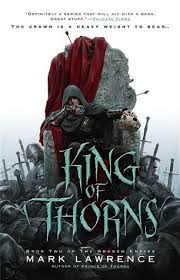
2‑King of Thorns
Chapter 30: Four years earlier
by Mark, Lawrence,The chapter “29: Four years earlier” serves as a flashback, providing critical context for the events unfolding in *King of Thorns*, the second book of *The Broken Empire* series. It revisits a pivotal moment in the protagonist’s past, shedding light on the formative experiences that shaped his current trajectory. The narrative shifts temporally to explore key decisions, alliances, or conflicts that continue to influence the present storyline, offering readers deeper insight into the character’s motivations and the world’s complexities.
The flashback likely delves into the protagonist’s earlier struggles, revealing how he began consolidating power or confronting adversaries. This retrospective lens highlights the origins of his ruthlessness or strategic brilliance, traits central to his identity as the “King of Thorns.” By examining his past actions, the chapter underscores the themes of ambition, survival, and moral ambiguity that define the series, while also foreshadowing future challenges or unresolved tensions.
The chapter’s structure emphasizes contrast between past and present, illustrating how time has altered the protagonist’s circumstances or perspective. It may introduce secondary characters or events that remain relevant in the current timeline, weaving a richer tapestry of cause and effect. The flashback serves not only as exposition but also as a narrative device to deepen emotional stakes, making the protagonist’s journey more compelling.
Ultimately, this chapter bridges gaps in the overarching plot, ensuring continuity between the series’ installments. It reinforces the cyclical nature of power and conflict in *The Broken Empire*, where history often repeats itself. By revisiting the past, the author invites readers to reflect on how far the protagonist has come—and what sacrifices or betrayals still haunt him. This introspective interlude enriches the story’s depth, setting the stage for the next phase of his tumultuous reign.
FAQs
1. What is the significance of the chapter title “29: Four years earlier” in the context of the book’s narrative structure?
Answer:
The chapter title “29: Four years earlier” indicates a flashback or temporal shift in the narrative, common in Mark Lawrence’s storytelling style. This structure serves to provide crucial backstory or context for current events in “King of Thorns.” By jumping four years into the past, the author likely reveals formative experiences, motivations, or key events that shaped the protagonist’s present circumstances. Such temporal shifts are particularly important in the Broken Empire series, where Jorg’s past actions heavily influence his present kingship and the empire’s fractured state.2. How does the abrupt transition to this flashback chapter affect the reader’s understanding of Jorg’s character?
Answer:
The sudden shift to events four years prior forces readers to recontextualize Jorg’s present actions through past experiences. This technique allows for deeper character development, showing how younger Jorg’s choices, traumas, or triumphs created the hardened ruler seen in the present timeline. The contrast between past and present Jorg highlights his transformation, whether through loss, violence, or strategic thinking. Such flashbacks are crucial for understanding the complex morality and motivations of this antihero protagonist in the grimdark fantasy setting.3. What narrative purpose might this specific temporal placement (four years earlier) serve compared to other possible time jumps?
Answer:
A four-year jump back likely captures a pivotal transition period in Jorg’s life - old enough for consequential decisions but recent enough to directly impact present events. This specific timeframe may reveal: 1) The immediate aftermath of key events from “Prince of Thorns,” 2) Jorg’s early challenges establishing his rule, or 3) The origins of current conflicts. Unlike a longer jump that might feel disconnected, four years maintains narrative tension by showing direct cause-and-effect relationships between past actions and present consequences in the Broken Empire.4. How might Lawrence use this chapter to subvert reader expectations established in previous chapters?
Answer:
By revealing past events out of chronological order, Lawrence can: 1) Withhold crucial information that recontextualizes present actions, 2) Show younger Jorg behaving differently than his current ruthless persona suggests, or 3) Reveal that apparent victories in the present timeline actually stem from past failures or compromises. This technique keeps readers actively piecing together the narrative, while allowing for shocking reveals that challenge assumptions about characters’ motivations or the empire’s current state of decay and warfare.5. What thematic elements from the Broken Empire series are likely emphasized through this flashback structure?
Answer:
The flashback probably reinforces core series themes: 1) The cyclical nature of violence and power in the Broken Empire’s feudal system, 2) How trauma and past experiences shape (or distort) leadership, 3) The unreliable nature of memory and perspective, and 4) The consequences of youthful decisions on mature rule. By juxtaposing past and present, Lawrence emphasizes that in this brutal world, one’s history never truly remains buried - it resurfaces to haunt both individuals and the empire itself.
Quotes
1. “The chapter title ‘29: Four years earlier’ immediately sets a temporal shift, hinting at a flashback or pivotal backstory moment.”
This opening establishes the chapter’s structure as a retrospective, suggesting we’re about to learn crucial history that shapes current events in the Broken Empire saga.
2. “King of Thorns: Book Two of the Broken Empire”
As the series title reappears here, it reinforces the dark, regal conflict central to the narrative while marking this chapter’s placement in the larger trilogy structure.
3. “The sparse presentation of just a chapter number and time marker creates deliberate narrative tension.”
This minimalist approach forces readers to focus on the significance of this specific flashback period in the protagonist’s journey to power.
